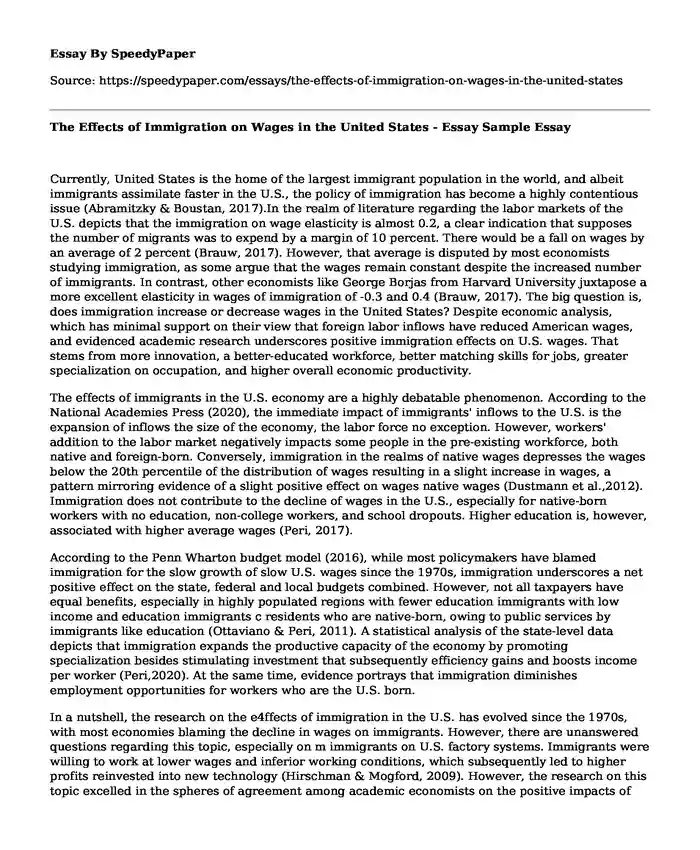
| Type of paper: | Essay |
| Categories: | United States Economics Minimum wage |
| Pages: | 4 |
| Wordcount: | 874 words |
Currently, United States is the home of the largest immigrant population in the world, and albeit immigrants assimilate faster in the U.S., the policy of immigration has become a highly contentious issue (Abramitzky & Boustan, 2017).In the realm of literature regarding the labor markets of the U.S. depicts that the immigration on wage elasticity is almost 0.2, a clear indication that supposes the number of migrants was to expend by a margin of 10 percent. There would be a fall on wages by an average of 2 percent (Brauw, 2017). However, that average is disputed by most economists studying immigration, as some argue that the wages remain constant despite the increased number of immigrants. In contrast, other economists like George Borjas from Harvard University juxtapose a more excellent elasticity in wages of immigration of -0.3 and 0.4 (Brauw, 2017). The big question is, does immigration increase or decrease wages in the United States? Despite economic analysis, which has minimal support on their view that foreign labor inflows have reduced American wages, and evidenced academic research underscores positive immigration effects on U.S. wages. That stems from more innovation, a better-educated workforce, better matching skills for jobs, greater specialization on occupation, and higher overall economic productivity.
The effects of immigrants in the U.S. economy are a highly debatable phenomenon. According to the National Academies Press (2020), the immediate impact of immigrants' inflows to the U.S. is the expansion of inflows the size of the economy, the labor force no exception. However, workers' addition to the labor market negatively impacts some people in the pre-existing workforce, both native and foreign-born. Conversely, immigration in the realms of native wages depresses the wages below the 20th percentile of the distribution of wages resulting in a slight increase in wages, a pattern mirroring evidence of a slight positive effect on wages native wages (Dustmann et al.,2012). Immigration does not contribute to the decline of wages in the U.S., especially for native-born workers with no education, non-college workers, and school dropouts. Higher education is, however, associated with higher average wages (Peri, 2017).
According to the Penn Wharton budget model (2016), while most policymakers have blamed immigration for the slow growth of slow U.S. wages since the 1970s, immigration underscores a net positive effect on the state, federal and local budgets combined. However, not all taxpayers have equal benefits, especially in highly populated regions with fewer education immigrants with low income and education immigrants c residents who are native-born, owing to public services by immigrants like education (Ottaviano & Peri, 2011). A statistical analysis of the state-level data depicts that immigration expands the productive capacity of the economy by promoting specialization besides stimulating investment that subsequently efficiency gains and boosts income per worker (Peri,2020). At the same time, evidence portrays that immigration diminishes employment opportunities for workers who are the U.S. born.
In a nutshell, the research on the e4ffects of immigration in the U.S. has evolved since the 1970s, with most economies blaming the decline in wages on immigrants. However, there are unanswered questions regarding this topic, especially on m immigrants on U.S. factory systems. Immigrants were willing to work at lower wages and inferior working conditions, which subsequently led to higher profits reinvested into new technology (Hirschman & Mogford, 2009). However, the research on this topic excelled in the spheres of agreement among academic economists on the positive impacts of wages on native-born American workers. Despite immigrants being beneficial to the labor supply, they are also consumers of goods and services, resulting in more jobs (Shierholz, 2010). Finally, the research question fits in the research. It answers the negative and positive impacts of wages and employment in the realms of immigration non the economic scale.
References
Abramitzky, R., & Boustan, L. (2017). Immigration in American economic history. Journal ofEconomic Literature, 55(4), 1311-1345. https://doi.org/10.1257/jel.20151189
Brauw, A. (2017, September 17). Does immigration reduce wages? Cato Institute. https://www.cato.org/cato-journal/fall-2017/does-immigration-reduce-wages
Dustmann, C., Frattini, T., & Preston, I. P. (2012). The effect of immigration, along with thedistribution of wages. The Review of Economic Studies, 80(1), 145-173. https://doi.org/10.1093/restud/rds019
Hirschman, C., & Mogford, E. (2009). Immigration and the American Industrial Revolution from1880 to 1920. Social Science Research, 38(4), 897-920 https://doi.org/10.1016/j.ssresearch.2009.04.001
Ottaviano, I., & Peri, G. (2011). Rethinking the effect of immigration on wages. Journal ofthe European Economic Association, 10(1), 152-197. https://doi.org/10.1111/j.1542-4774.2011.01052.x
Peri, G. (2010, January 1). (PDF) The effect of immigrants on U.S. employment and productivity.ResearchGate. https://www.researchgate.net/publication/46566232_The_Effect_of_Immigrant
Peri, G. (2017, September 17). The impact of immigration on the wages of unskilled workers. CatoInstitute. https://www.cato.org/cato-journal/fall-2017/impact-immigration-wages-unskilled-workers
Shierholz, H. (2010, February 4). Immigration and wages: Methodological advancementsconfirm modest gains for native workers. Economic Policy Institute. https://www.epi.org/publication/bp255/
The effects of immigration on the United States’ economy — Penn Wharton budget model. (2016,June 27). Penn Wharton Budget Model. https://budgetmodel.wharton.upenn.edu/issues/2016/1/27/the-effects-of-immigration-on-the-united-states-economy
Five employment and wage impacts of immigration: Empirical evidence | The economic and fiscalconsequences of immigration | The National Academies Press. (, 2020). The NationalAcademies Press. https://www.nap.edu/read/23550/chapter/9
Cite this page
The Effects of Immigration on Wages in the United States - Essay Sample. (2023, Dec 16). Retrieved from https://speedypaper.net/essays/the-effects-of-immigration-on-wages-in-the-united-states
Request Removal
If you are the original author of this essay and no longer wish to have it published on the SpeedyPaper website, please click below to request its removal:
- Compare and Contrast Essay on Literature Pieces
- Free Essay on Different Factors That Inhibited the Development of International Trade
- Rose Bowl Massacre - Paper Example
- Essay Sample on Ports and Intermodalism
- Free Essay on Remembering the Forgotten War: The War Between United States and Mexico
- Paper Example: Paying Better Than My Competition
- Agribusiness: Understanding Climatic Dependence & Seasonality - Essay Sample
Popular categories




